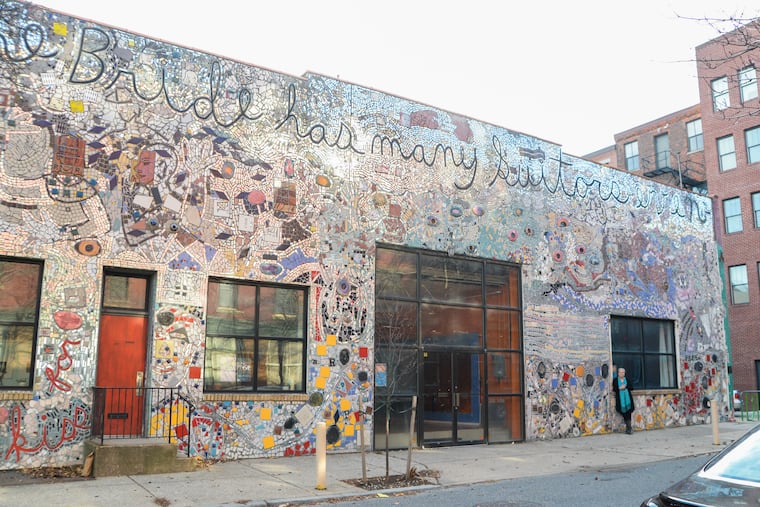Painted Bride seeks court approval for sale of its Old City building, sheathed with Zagar mosaics
Zagar may attempt a long shot for protection using federal law.

The Painted Bride Art Center, the city’s oldest alternative arts space, is seeking court approval for the sale of its landmark Vine Street building, encrusted with Isaiah Zagar’s mirrored mosaics created over the course of nearly a decade.
According to a petition filed in Common Pleas Court this week, the Bride agreed to sell the building last fall for $4.8 million to Groom Investments, a subsidiary of Maxim Capital, a private equity investment group. Maxim has partners in the deal to develop the site, including Atrium Design Group.
An alternative $2.6 million bid from Lantern Theater Company, which would preserve the mosaics and retain the building as a performing arts space, was rejected.
The Painted Bride board of directors ratified the sale May 7.
Laurel Raczka, executive director of the Bride, said it was unclear how long it would be before Orphans’ Court, which handles matters involving nonprofits and charities, takes up the case and renders a decision.
In the meantime, Raczka said, the Bride has been looking “at different spaces in the city” that might serve for a base of operations. The organization sees its future unfolding without a building for performances. Rather, she said, it will seek partners and community groups interested in different kinds of programming, which the Bride intends to bring to neighborhoods all over the city.
Joe Grace, spokesperson for Josh Shapiro, state attorney general, said that the Attorney General’s Office had received the Bride’s court petition and that “the matter will be decided by the Orphans’ Court.
Lawyers for the Bride maintain that the law does not require any approvals from the court but that the Painted Bride is seeking them nonetheless. The Bride’s petition states that “given the history” of the building, the Bride “wishes to obtain approval of the sale from both the Pennsylvania Office of the Attorney General and the Philadelphia Orphans’ Court.”
Jonathan Stein, an attorney and member of a coalition of artists and community members seeking to save the Zagar murals and the Bride building as a performance space, disputed that view.
“They’re selling a charitable asset to a private developer, and under state charitable trust law, that requires Orphans’ Court and attorney general approval," Stein said.
“The property has been a part of the Philly art scene for a long time,” said Raczka. “The potential sale of the building has stirred up some strong feelings in the community. The Bride and the buyer would like for Orphans’ Court to approve the sale to confirm to the community that the Painted Bride is acting in accordance with its charitable mission and securing its future as a vibrant nonprofit.”
Marc J. Sonnenfeld, an attorney for the Bride, said the building “is merely a venue for the Bride; it is not necessary for fulfilling the Bride’s mission.”
“The Bride’s new vision is to bring the arts to under-resourced communities that lack access to the arts,” he continued. “To ensure its future, the Bride can no longer fight a losing battle to maintain the building and the mosaic, particularly as the building no longer serves the Bride’s strategic vision.”
Maxim Capital could not be reached for comment on plans for the building; its attorney, Richard Pressman, did not respond to inquiries.
The plan to sell the building became public at the end of 2017. There was no concurrent plan to preserve the Zagar mosaics, which cover every wall, and the Bride has not proposed one since then.
Fearing demolition, officials at Philadelphia’s Magic Gardens, a South Street destination that cares for and presents Zagar’s extensive mosaic work in the area, nominated the Bride and its mosaics for placement on the Philadelphia Register of Historic Places. A number of neighborhood residents, artists, and museum curators spoke in favor of saving the Bride’s mosaics.
Emily Smith, executive director of Magic Gardens, offered the expertise of her conservators (who number Zagar among them) gratis to the Bride: If the building were not destroyed, Magic Gardens would preserve the mosaics in perpetuity.
In September , the full Philadelphia Historical Commission ignored the recommendation of its own historic designation committee and rejected the Bride for historic landmark designation.
Zagar, upset with the possibility that a decade of his work faces possible obliteration, may invoke the federal Visual Artists Rights Act, which prohibits destruction of works of art in certain limited instances. He has made no decision.
“Other mosaics of mine have been taken down,” Zagar said. “This is one that was significant in terms of the time and the heart put into it.”